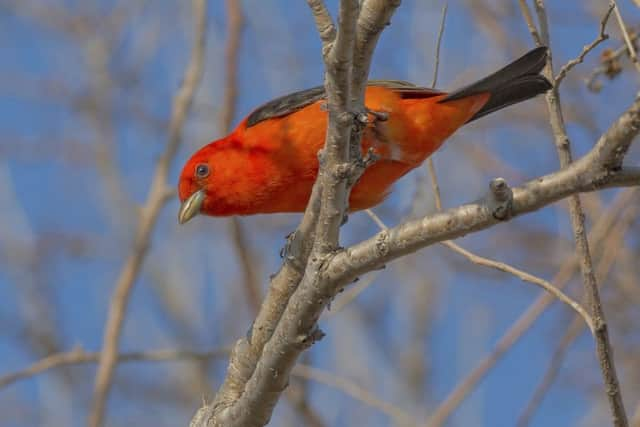Twitchers flocking to Barra in search of rare bird


Twitchers from across the country are flocking to a tiny island in the Outer Hebrides after a scarlet tanager was blown there from across the Atlantic.
The distinctive bird has only been officially recorded in the UK and Ireland ten times in the past.
Advertisement
Hide AdAdvertisement
Hide AdNow a young male of the species has been found at Creachan woodland on the Isle of Barra. It was first discovered on Monday and was still on the island on Tuesday.
News of the rare visitor spread rapidly across social media sites, prompting avid birdwatchers to head for the island in the hope of catching a glimpse.
Similar occurrences have sparked an off-season boost visitor numbers on Barra, which can only be reached by ferry or light aircraft.
The tourist office on the island has reported a 58 per cent increase in visitors over the last month compared to the same period last year.
This ties in with the main migration period for many American birds, according to Jamie Boyle, Uist reserves manager for wildlife charity RSPB Scotland.
“The scarlet tanager is one of the really big ones - not only is it incredibly rare but it’s spectacular,” he said.
“Dozens of birwatchers are descending on Barra at this time every year in the hope of seeing something rare like this American bird.
“It has turned into a mini tourist boom, as everywhere else goes quiet and suddenly all these bird enthusiasts descend on Barra.
Advertisement
Hide AdAdvertisement
Hide Ad“We get quite a few American species turning up in the Western Isles and Barra has proved to be quite a hotspot.
“We think it’s because birds get blown off course and when they end up in the Western Isles they are still following their migration pattern.
“Most of the birds are migrating from North America, heading to South America, so they carry on going south, heading down the chain of islands and they end up in Barra as the last resort, sort of.
“So if you get a good couple of gales, with westerly Atlantic lows coming in, there is a good chance of a couple of these American birds getting caught up in these storms and shifted right across the Atlantic.
“That little area of Barra is now turning up all sorts of things.”
“The last time one turned up in the UK was 2011, so many birders will want to go to Barra to see it,” said a spokesman for the wildlife news and information website Bird Guides.
“It has probably got caught up in the recent strong storms and been swept by the winds across the Atlantic.
“Of the previous records, six have been in the West Country and four in Ireland.
Advertisement
Hide AdAdvertisement
Hide Ad“It has never been recorded this far north in Britain before.
“It is an exciting find and a first for Scotland.”
Visitors arriving by air touch down on the sandy Traigh Mhor beach, which has been voted the world’s most stunning landing spot.
It is also the only place on the planet where scheduled flights work round the tides.
Alan MacKenzie, VisitScotland islands manager for the Hebrides, said: “The Outer Hebrides really is a paradise for birdwatchers, with the diverse habitats across the islands home to a huge variety of species, from golden eagles to puffins.
“When special visitors such as the scarlet tanager make the trip to Barra, it is only natural that enthusiastic birdwatchers follow suit and this is obviously great news for the local economy.
“Overall, wildlife tourism plays a big role in Scottish tourism and brings in around £127 million to the country’s economy.”
Male scarlet tanagers in their breeding colours are described as “among the most blindingly gorgeous birds in an eastern forest in summer, with blood-red bodies set off by jet-black wings and tail”.
They breed within large stretches of deciduous forest across eastern North America and winter in the Andean foothills.
Advertisement
Hide AdAdvertisement
Hide AdAfter breeding, adult males moult their red feathers and replace them with a yellow-green plumage similar to the female’s but with black wings and tail.
The Hebridean visitor is believed to be a first-winter male, which has the same colouring as a female.
Sadly it has little chance of survival after being blown so far off course, according to Mr Boyle.
He said alien species are easily spotted and often quickly picked off by predators.
The previous UK sighting was three years ago in the Isles of Scilly, off the coast of Cornwall.